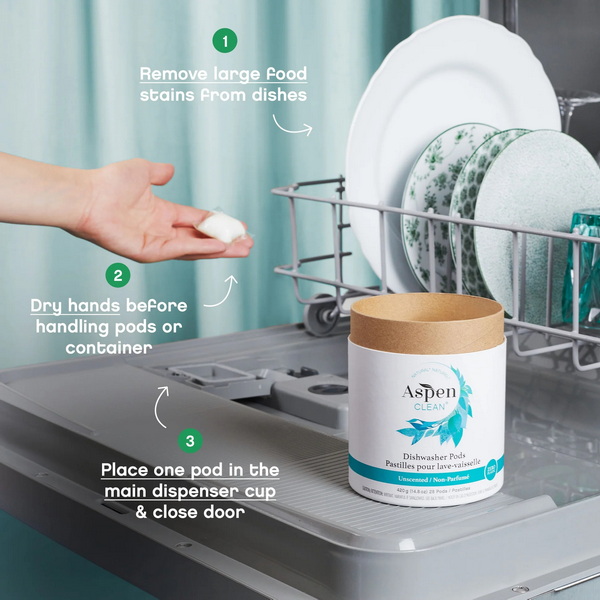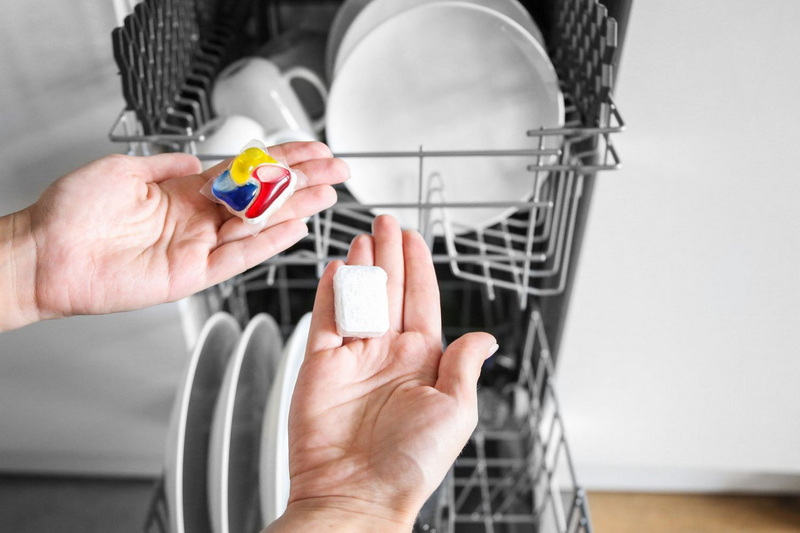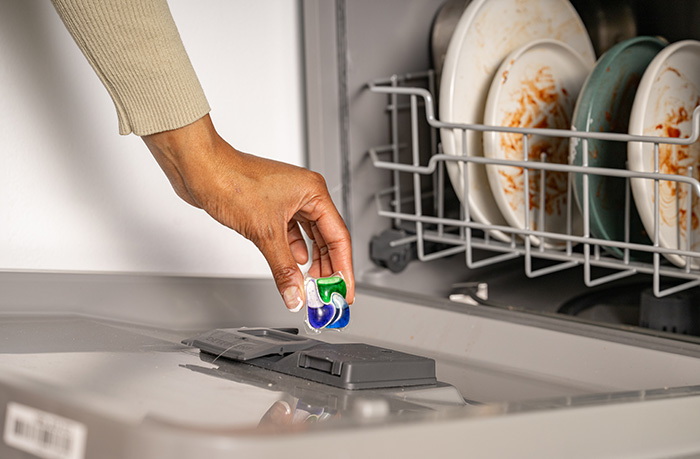Dongguan UFine Daily Chemical Co.,Ltd.
- All
- Product Name
- Product Keyword
- Product Model
- Product Summary
- Product Description
- Multi Field Search
Views: 222 Author: Tomorrow Publish Time: 10-29-2025 Origin: Site











Content Menu
● Biodegradability: core concepts
● Dishwasher pods: typical composition
● Are dishwasher pods biodegradable by default?
● Factors that influence biodegradability in dishwasher pods
● Environmental considerations beyond biodegradability
● Historical context and evolving regulations
● Practical guidance for consumers
● Advances in formulation science
● Manufacturing practices and supply chain considerations
● Brand claims and consumer literacy
● Case studies: observed outcomes in real environments
● Common misconceptions expanded
● Process for evaluating a pod on biodegradability (step-by-step)
● FAQ
>> 1. What does “biodegradable” mean in the context of dishwasher pods?
>> 2. Do all dishwasher pods biodegrade in home septic systems?
>> 3. Can a pod be biodegradable but still harmful to aquatic life?
>> 4. How can I tell if the film around a pod is biodegradable?
>> 5. Is it better to choose pods with phosphates or without?
The demand for eco-friendly household products has surged in recent years, and dishwasher pods are no exception. Consumers increasingly seek sustainable options that minimize environmental impact without compromising cleaning performance. This article examines whether dishwasher pods are biodegradable, what ingredients influence biodegradability, how manufacturing practices affect environmental footprint, and practical tips for choosing greener options. We will cover the science behind biodegradability, certifications to look for, and common misconceptions. By the end, readers will have a clearer framework for evaluating dishwasher pods through an environmental lens.

Biodegradability refers to the ability of a substance to be broken down by microorganisms into natural, non-toxic components such as water, carbon dioxide, and biomass. The rate and extent of biodegradation depend on several factors:
- Chemical composition: Some surfactants and additives resist microbial degradation; others are readily metabolized.
- Polymer content: Pods often use film coatings or encapsulation materials that may persist in the environment if not designed to biodegrade.
- Environmental conditions: Temperature, pH, oxygen availability, and the presence of specific microorganisms influence degradation rates.
- End-products: Even if a compound degrades, its breakdown products must be non-toxic to avoid secondary environmental harm.
Dishwasher pods are complex formulations designed to deliver cleaning agents efficiently. Common components include:
- Surfactants: Anionic, nonionic, or amphoteric surfactants reduce surface tension and help remove grease. Some classes degrade readily; others persist longer in the environment.
- Builders and enzymes: Builders soften water and enzymes target specific stains. Enzymes are proteins that can be biodegradable under proper conditions but may require careful handling in formulations.
- Bleaching agents: Odorless bleach compounds assist in stain removal. Some chlorine-releasing bleaches can have environmental implications if not managed properly.
- Encapsulation and films: Pods are enclosed in a polyethylene or polyvinyl alcohol (PVA) film, or other water-soluble materials. The biodegradability of these films varies and can influence the overall pod's environmental fate.
- Not all dishwasher pods are inherently biodegradable. Biodegradability depends on the specific ingredients, packaging, and labeling claims.
- Some pods use biodegradable or compostable film coatings (e.g., PVA-based films designed to dissolve in water) but may still contain non-biodegradable residues if other components persist.
- Certification and third-party verification help consumers identify genuinely biodegradable options. Look for explicit claims and recognized standards discussed below.
- Film and packaging: Water-soluble films need to dissolve during the wash cycle. If the film does not fully dissolve, it could contribute persistent plastic fragments to the wastewater.
- Surfactants: Aliphatic and some polyoxyethylene-based surfactants can be biodegradable under standard wastewater treatment conditions. Others may persist if used in high concentrations.
- Enzymes: Many enzymes are biodegradable, but their activity depends on pH and temperature. Incomplete dissolution can affect overall degradability.
- Additives: Fragrances, dyes, phosphates (where still allowed), and anti-foaming agents vary in biodegradability. The presence of phosphates is restricted in many regions due to eutrophication concerns.
- Certification: Brands may pursue ecolabels or certifications that attest to biodegradability under certain conditions (e.g., standard testing environments).
- Wastewater treatment: Biodegradability is important, but the effectiveness of municipal or on-site wastewater treatment also determines environmental outcomes.
- Aquatic toxicity: Some biodegradable substances may still be toxic to aquatic life at certain concentrations before biodegradation completes.
- Microplastics: Non-biodegradable outer packaging or film fragments can contribute to microplastic pollution if not fully dissolved.
- Resource use: Production processes and raw material sourcing influence cradle-to-grave sustainability.
- Regulatory shifts: Regions around the world have tightened rules on surfactant types, phosphate usage, and packaging materials in household cleaners.
- Industry responses: Manufacturers are increasingly disclosing lifecycle information and seeking third-party verifications to address consumer demand for transparency.
- Consumer awareness: As public interest in sustainability grows, more buyers scrutinize biodegradability claims, prompting clearer labeling and standardized testing.

- Read labels carefully: Look for explicit biodegradability claims and the scope (e.g., "biodegradable in 28 days under test conditions" or "biodegradable film").
- Prefer products with water-soluble films designed to dissolve completely in wash water.
- Consider holistic impact: Biodegradability is one aspect; also evaluate packaging recyclability, phosphate content, and energy use in production.
- Follow disposal recommendations: When possible, dispose of pods per local guidelines to minimize environmental risk.
- Test in different water qualities: Hard water can influence the effectiveness and dissolution of films and surfactants, affecting real-world biodegradability.
- Biodegradable polymers: Researchers are developing new water-soluble, non-toxic polymers for pod encapsulation that break down more readily in wastewater.
- Safer surfactants: Industry scientists optimize surfactants to balance cleaning performance with faster biodegradation while maintaining safety for aquatic ecosystems.
- Enzyme stabilization: Innovations improve enzyme stability in pods without sacrificing post-use biodegradation, enabling robust cleaning performance with eco-friendly profiles.
- Phosphate alternatives: Phosphorus-free builders and activators help mitigate eutrophication concerns and align with stricter regulations.
- Ingredient sourcing: Sustainable sourcing of raw materials reduces environmental footprint and supports greener supply chains.
- Packaging design: Designing films and packaging that are fully biodegradable or highly recyclable minimizes end-of-life waste.
- Wastewater management: Facilities with advanced effluent treatment can maximize biodegradation before discharge, benefiting ecosystems downstream.
- Quality control: Rigorously testing products for real-world biodegradability ensures marketing claims reflect actual performance.
- Clear labeling: Brands that provide third-party test data, reference standards, and condition-specific biodegradability claims enable better consumer decisions.
- Certifications to watch for: Independent ecolabels and biodegradability certifications provide credibility beyond marketing language.
- Skeptical reading: Consumers should beware vague terms like "eco-friendly" without substantiation or test data.
- Urban wastewater systems: Biodegradable components typically degrade during primary and secondary treatment, reducing persistent residues in effluent for well-designed formulations.
- Rural septic systems: Home septic environments rarely replicate industrial-scale treatment; certain biodegradable components may persist longer, so product selection matters.
- Aquatic environments: In bodies of water receiving wastewater effluent, the rate of biodegradation and potential toxicity of breakdown products influence environmental impact.
- Misconception: Biodegradability guarantees safety to wildlife. Reality: Biodegradability does not guarantee absence of toxic effects during breakdown or in byproducts.
- Misconception: Eco-labels equal biodegradability. Reality: Some labels focus on overall sustainability, not solely biodegradability of all ingredients.
- Policy harmonization: International guidelines may converge on testing standards, improving cross-border comparisons of biodegradability claims.
- Consumer education: Ongoing outreach will help shoppers interpret labels and understand trade-offs among cleaning efficacy, packaging, and end-of-life impact.
- Innovation cycles: Expect continued improvements in film materials, surfactants, and enzymes that offer better environmental profiles without compromising performance.
1. Identify the film material and confirm it is water-soluble and designed to dissolve completely in typical wash conditions.
2. Check the surfactant class and verify biodegradability under standard wastewater treatment simulations.
3. Review enzyme stability and confirm that the enzymes are designed to degrade after their action without leaving persistent residues.
4. Look for third-party biodegradability verification and the specific test conditions used.
5. Assess packaging for recyclability or biodegradability; ensure the outer packaging aligns with local waste management practices.
6. Consider regional regulations on phosphates and other additives; prefer phosphate-free formulations if available.
7. Compare with alternative products using a consistent framework to evaluate trade-offs between cleaning performance, cost, and environmental impact.
Practical guidance for businesses (beyond consumers)
- Lifecycle assessments: Conduct LCAs to quantify environmental impacts from cradle to grave and identify hotspots for improvement.
- Transparent communication: Publish test data and the scope of biodegradability claims to build trust with customers and regulators.
- Collaboration with regulators: Engage with environmental agencies to align claims with current rules and emerging standards.
- Innovation investment: Fund R&D in biodegradable films, safer surfactants, and energy-efficient manufacturing.
Biodegradability is a meaningful criterion when evaluating dishwasher pods, but it is not the sole determinant of environmental impact. A holistic assessment should include packaging materials, the biodegradability of all components, potential aquatic toxicity, and overall lifecycle considerations. When in doubt, favor products with clear, third-party biodegradability data, water-soluble films designed to dissolve completely, and minimal non-biodegradable packaging. Consumers empowered with detailed information can choose greener dishwasher pods that align with broader sustainability goals.

Biodegradable means the product or its components can be broken down by microorganisms into natural, non-toxic substances under certain conditions, typically in an environment that supports microbial activity over a defined period.
Not necessarily. Some components may biodegrade in wastewater treatment facilities but not in home septic systems, where conditions differ. Always check the product’s label and test data.
Yes. Some substances degrade slowly or produce toxic byproducts during breakdown. Look for certifications that address both biodegradability and aquatic toxicity.
Check the packaging for explicit claims about a water-soluble or biodegradable film and any applicable standards. If uncertain, contact the manufacturer for data on the film's composition and degradation performance.
Without phosphates is generally better for the environment, as phosphates contribute to eutrophication in water bodies. Many regions regulate phosphate use; opt for phosphate-free formulations when possible.